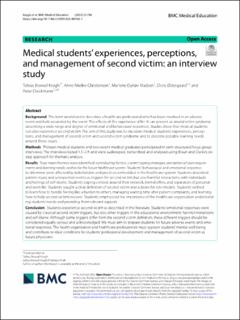| dc.contributor.author | Krogh, Tobias Browall | |
| dc.contributor.author | Mielke-Christensen, Anne | |
| dc.contributor.author | Madsen, Marlene Dyrløv | |
| dc.contributor.author | Østergaard, Doris | |
| dc.contributor.author | Dieckmann, Gerhard Peter | |
| dc.date.accessioned | 2023-11-15T08:32:40Z | |
| dc.date.available | 2023-11-15T08:32:40Z | |
| dc.date.created | 2023-11-09T12:37:30Z | |
| dc.date.issued | 2023 | |
| dc.identifier.citation | Krogh, T. B., Mielke-Christensen, A., Madsen, M. D., Østergaard, D., & Dieckmann, P. (2023). Medical students’ experiences, perceptions, and management of second victim: An interview study. | en_US |
| dc.identifier.issn | 1472-6920 | |
| dc.identifier.uri | https://hdl.handle.net/11250/3102618 | |
| dc.description.abstract | The term second victim describes a healthcare professional who has been involved in an adverse event and feels wounded by the event. The effects of this experience differ. It can present as second victim syndrome, describing a wide range and degree of emotional and behavioural responses. Studies show that medical students can also experience second victim. The aim of this study was to elucidate medical students’ experiences, perceptions, and management of second victim and second victim syndrome and to describe possible learning needs around these issues.
Thirteen medical students and two recent medical graduates participated in semi-structured focus group interviews. The interviews lasted 1.5–2 h and were audiotaped, transcribed, and analysed using Braun and Clarke’s six-step approach for thematic analysis.
Four main themes were identified: contributing factors; current coping strategies; perception of own requirements and learning needs; wishes for the future healthcare system. Students’ behavioural and emotional response to dilemmas were affected by stakeholders and practices embedded in the healthcare system. Students described patient-injury and unexpected events as triggers for second victim, but also harmful interactions with individuals and feelings of self-blame. Students’ coping centred around their network, formal offers, and separation of personal- and work-life. Students sought a clear definition of second victim and a desire for role-models. Students' wished to learn how to handle feeling like a burden to others, managing waiting time after patient complaints, and learning how to help second victims recover. Students emphasized the importance of the healthcare organisation understanding students’ needs and providing them relevant support.
Students experience second victim as described in the literature. Students’ emotional responses were caused by classical second victim triggers, but also other triggers in the educational environment: harmful interactions and self-blame. Although some triggers differ from the second victim definition, these different triggers should be considered equally serious and acknowledged. We must aim to prepare students for future adverse events and emotional responses. The health organisation and healthcare professionals must support students’ mental well-being and contribute to ideal conditions for students' professional development and management of second victim as future physicians. | en_US |
| dc.language.iso | eng | en_US |
| dc.publisher | Springer Nature | en_US |
| dc.rights | Navngivelse 4.0 Internasjonal | * |
| dc.rights.uri | http://creativecommons.org/licenses/by/4.0/deed.no | * |
| dc.title | Medical students’ experiences, perceptions, and management of second victim: an interview study | en_US |
| dc.title.alternative | Medical students’ experiences, perceptions, and management of second victim: an interview study | en_US |
| dc.type | Peer reviewed | en_US |
| dc.type | Journal article | en_US |
| dc.description.version | publishedVersion | en_US |
| dc.rights.holder | © The Author(s) 2023 | en_US |
| dc.subject.nsi | VDP::Medisinske Fag: 700 | en_US |
| dc.source.volume | 23 | en_US |
| dc.source.journal | BMC Medical Education | en_US |
| dc.source.issue | 1 | en_US |
| dc.identifier.doi | 10.1186/s12909-023-04763-7 | |
| dc.identifier.cristin | 2194529 | |
| cristin.ispublished | true | |
| cristin.fulltext | original | |
| cristin.qualitycode | 1 | |

